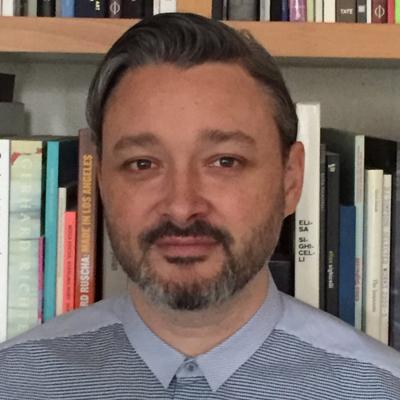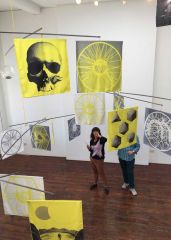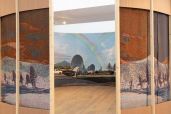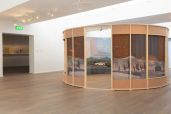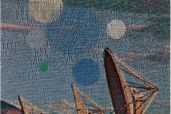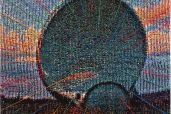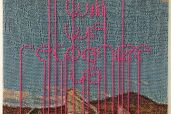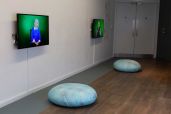AIR Alum
-George Bolster is a research-based Irish artist based in New York City, his work has been shown in museums and galleries throughout America and Europe. Bolster was awarded a 2013 artists residency from the Rauschenberg Foundation.
Image Gallery
Science Collaborator
Seth Shostak

Seth claims to have developed an interest in extraterrestrial life at the tender age of ten, when he first picked up a book about the Solar System.
Jill Tarter

Jill Tarter received her Bachelor of Engineering Physics Degree with Distinction from Cornell University and her Master’s Degree and a Ph.D. in Astronomy from the University of California, Berkeley.
Margaret Race
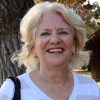
Margaret Race is concerned with protecting the planets. Actually, protecting all the planets: but especially Earth and Mars.
Laurance Doyle

Long before the discovery of the first planet beyond our solar system, astronomer Laurance Doyle began theorizing about the habitability of planets around other stars, clarifying the conditions needed for a planet to bear life.
Work
You Are Made of Stardust, 2019. Double kinetic Mobile made from steel, motors, wood, rope, and duchess satin. Installation view at Solstice Arts Centre, Meath, Ireland.
This mobile adapts a quote by Astronomer and former SETI Director Jill Tarter “We are the products of a billion-year lineage of wandering stardust. We, all of us, are what happens when a primordial mixture of hydrogen and helium evolves for so long that it begins to ask where it came from.” In addition to the text and title the piece, Bolster includes a series of pointers signaling the evolution of our ability to critically look in order to analyze and conceptualize information. In a condensed fashion, it charts the formation of humans and of astronomy. From the faculty development of critical observation, to the technical advances that help us see more of the universe we are in. Our need to continually look at our past, enables us to reassess received knowledge, and develop a better, more informed future. This is important not simply for visual artists, but for everyone. This kinetic revolving text work creates a parallel of how the planets appear to us, and how we understand the solar system to be.
At Sirius Arts Centre, Cork, Ireland
At Solstice Arts Centre, Meath, Ireland
Our Life Mirrored by Two Suns: Kepler 16b, 2019. Commissioned by Sirius Arts Centre, Cork, Ireland. Installation view at Solstice Arts Centre, Meath, Ireland. Tapestry, wood, nails.
In this textile installation Bolster depicts an imagined version of the planet Kepler 16b, which was discovered by SETI scientist Laurance Doyle, as part of the Kepler Mission on the 15th of September 2011. Observing that it was circumbinary (orbiting two suns of differing scales), previously thought to be physically impossible, Doyle contacted film director George Lucas, to ask if they could name the planet after Luke Skywalker’s fictional home planet Tatooine from the film Star Wars (1977) which is similarly orbited - Lucas agreed. Bolster’s digital image made from a composite of filmed stills became subject to the analog technologies of warp and weft, which reassembled the image in woven form, and have necessarily become subject to approximation and interpretation. Kepler 16b, a planet that could support life, is shown here housing radio telescopes from the Allen Telescope Array in California, which are in part, used by scientists to listen for artificial signals from life forms on other planets. The piece embraces the possibility, that we on Earth are being listened to, as we are attempting to listen to and comprehend others across the gulf that is the visible and invisible universe of space.
George Bolster, Visible and Invisible Simultaneity, 2020. Jacquard tapestry and embroidery.
George Bolster, Everything You See, Hear, and Say is a Wave, 2020. Jacquard tapestry, décortiqué and embroidery.
George Bolster, The Human to Human Flaw, 2020. Jacquard tapestry and embroidery.
George Bolster, Mentor 1: Planetary Protector Margaret Race, 2018, and Mentor 2: Seth Shostak SETI Scientist and Startrek Cameo, 2018, Video and sound. Installation View at Solstice Arts Centre, Meath, Ireland.
In these talking head style films, Bolster splices together the artificiality of the green screen technique heavily associated with science fiction and a deconstructed documentary form featuring disassociative images to create a sense of disorientation between what we accept as real or fictional in representational terms. He then fuses this with the often bewildering facts revealed by his interviewees, staff from NASA and SETI (The Search for Extraterrestrial Intelligence Institute). On the left, Margaret Race discusses her role as planetary protector for Earth and the importance of her mentor Astronaut Scott Carpenter to her career in science, and on the right Seth Shostak who discusses the search for extraterrestrial intelligence, his radio show Big Picture Science and his cameo in Startrek.
The Moon, McMoons, and the Moon Museum, 2016. Single channel video, 47 mins 11 secs.
The Moon, McMoons, and the Moon Museum is a film that conflates the past, present and future possibilities, and necessity of space exploration. Beginning with the first art object to be unofficially sent to the Moon aboard the Apollo Twelve in 1969, The Moon Museum. Multiple narratives run simultaneously through the piece addressing: the ideas behind the Moon Museum; a multicultural narrative of human fascination with the Moon; McMoons the archive for the mapping of the Moon in preparation for the Apollo Missions and site of the Lunar Orbiter Image Recovery Project; and the Moon as a solution to the question of how we save our collective human cultural production, in the face of the environmental damage caused to this planet. It features interviews from artist Forrest Myers, and scientists Laurance Doyle, Jill Tarter and Douglas Vakoch who discuss the Moon from a variety of perspectives.
The Moon Museum an Experiments in Art and Technology (E.A.T.) project was instigated by artist Forrest Myers, featured contributions from Andy Warhol, John Chamberlain, Forrest Myers, Claes Oldenberg, David Novros, and Robert Rauschenberg. Bolster's use of the documentary format is combined with multiple non-linear narratives and sometimes contrasting ideas in fact and fiction. Through this he creates an expanded discourse of ideas as opposed to a single point of view.
Excerpt 1
Excerpt 2

